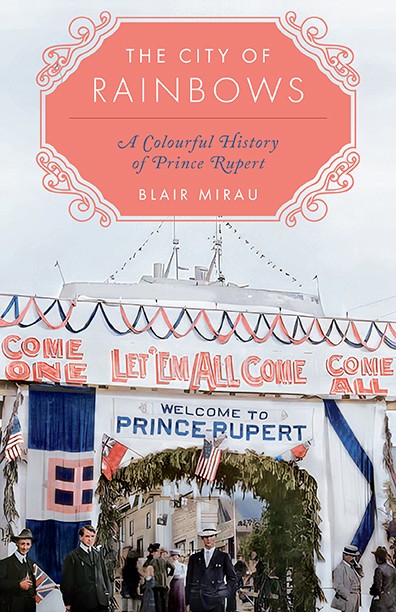
City of Rainbows: A Colourful History of Prince Rupert
Review By Robin Wylie
November 5, 2024
BC Studies no. 223 Autumn 2024 | p. 132-133
A town like Prince Rupert has a remarkably deep significance – and a volatile dynamic, as revealed in Blair Mirau’s survey.
Over the course of sixteen chapters the author recounts the ancient history of Ts’msyen peoples, European regional contact based on a reciprocal trade relationship (at communities such as Fort Simpson, Metlakatla, and Port Essington), then European settlement concentrated on Kaien Island (Prince Rupert) as the ultimate place of colonial development and settlement in this part of the Pacific Northwest.
Mirau reveals a story of complex communal development, touching on: the social-economic intensification of tribal peoples by 200 CE; the role of Indigenous trade and labour (and Christianization) within early European contact; the extraordinary promise of becoming a gateway to Asia through the building of the Grand Trunk Pacific (GTP); the boom associated with the American defense of Alaska; and resource export booms in the fishery and pulp industries which lasted until resource exhaustion; and modest recovery through federal-provincial port development (2007).
What can the reader conclude from this account? First, all local history in British Columbia benefits from recent anthropological and ethnohistorical accounts of ancient, socially complex Indigenous peoples as shown by scholars such as Charles Menzies. Indigenous people had dynamic societies before contact. Early contact could be not just reciprocal but revelatory in showing communal property relations – ones not recognized by settler society until recently.
Secondly, Prince Rupert’s grand ambitions were subject to uncontrollable external forces, the machinations of Charles Hays in building the GTP (as fully revealed in Frank Leonard’s study) resulting in bankruptcy, and the mortgaging of city credit to salvage the Watson Island pulp plant (the community’s largest employer and taxpayer) from the 1970s to 2017.
While the author emphasizes the positive in structuring the story of Prince Rupert through its modern branding with the rainbow symbol, the community has repeatedly gone through boom and bust periods which have dashed its aspirations to become a major city. Still, the creation of better port facilities, and perhaps the export of liquified natural gas, keeps the dream alive.
The author, reflecting the present nature of Prince Rupert, emphasizes trade as the community’s primary driver. But Ts’mseyn trade was based on rich maritime resources, and later the extraction of furs and gold. Prince Rupert became the world’s leader in the halibut fishery and there was large-scale pulp production. All suggest that Prince Rupert’s development relied just as much on local resource production as being a trading point between places.
The book would benefit from a more explicit discussion of politics. Despite its small size, a volatile economy, deep divisions between Indigenous and settler society, and the class and racial divisions within settler society produced a vigorous and deeply divided local politics. The struggle for racial equality, for example, didn’t just turn on spontaneous riots in the 1950s over liquor. Unionization of fishery and shore workers was intensely politicized as shown by Rolf Knight’s oral histories.
On the other hand, Mirau, based on his experience as a municipal councillor, offers measured advice about the future of Prince Rupert. One needs vision, but not hallucinations. One needs to prepare for downturns, not just upturns. Prince Rupert did go bankrupt in the 1930s and has repeatedly entered debt crises. The need for reserve funds, a municipal sovereign fund, is a striking conclusion about how to be prudent as well as visionary.
This is a well crafted and resourced account of a small community (illustrated with fourteen ‘colourful character’ profiles) with an outsized impact on the region, the province, the country, and perhaps even internationally.
Publication Information
Mirau, Blair, City of Rainbows: A Colourful History of Prince Rupert. Victoria: Heritage House, 2024. 256 pp. $24.95, paper.
